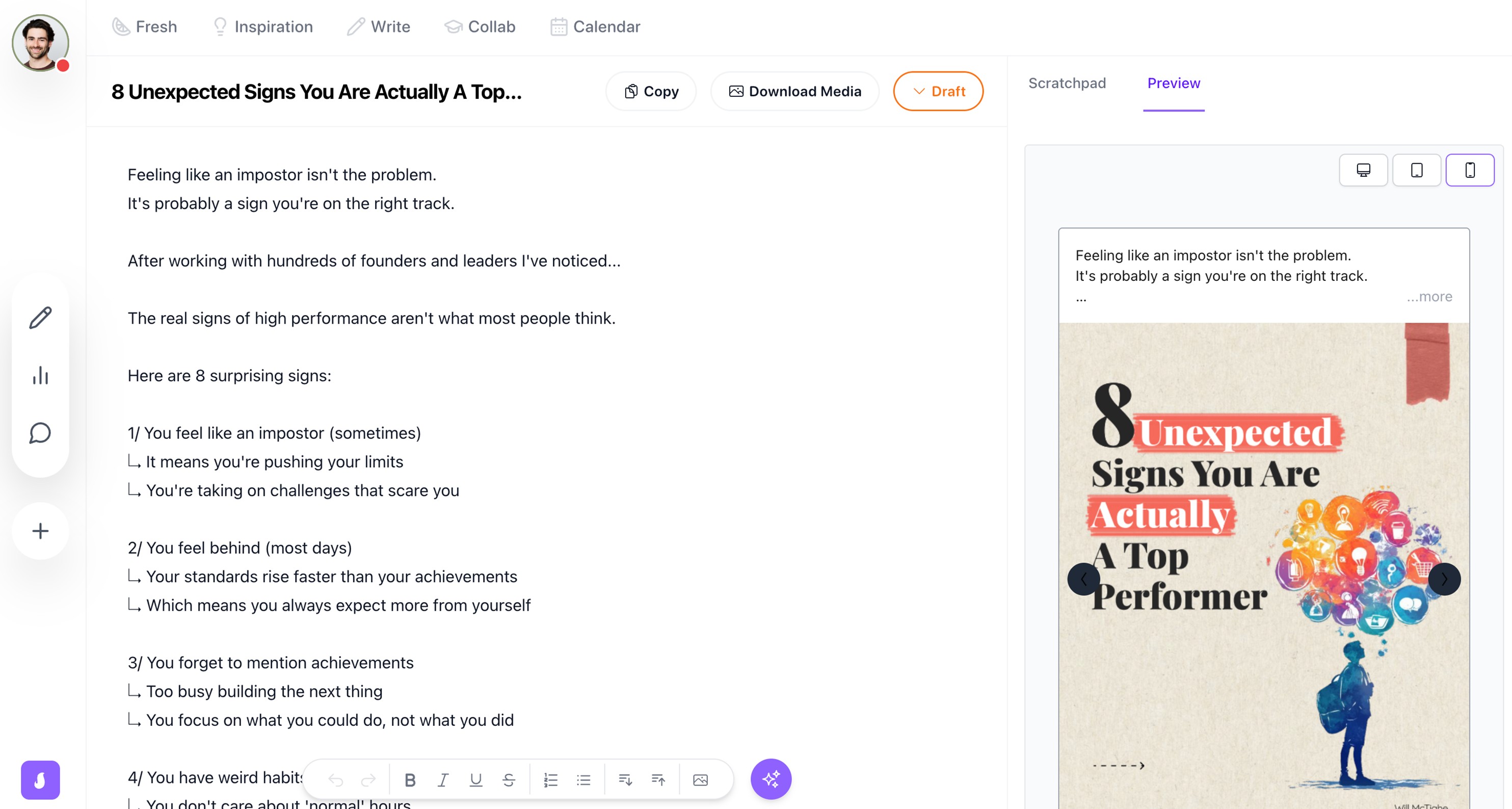
How the LinkedIn Algorithm Works [July 2025]

Will McTighe
July 20, 2025
Last updated: July 20, 2025
Introduction
It's Will McTighe here. Over the past 17 months, I've grown from 3,000 to 380,000+ followers on LinkedIn, and during that time I've watched the LinkedIn algorithm change dramatically. Keeping track of these shifts is exhausting.
If you've been on LinkedIn lately, you've probably noticed something's different. Your feed is showing posts from 3 weeks ago. Your reach has tanked. And those carousels that used to fly are not quite having the same effect as before.
We analyzed over 223,000 LinkedIn posts to understand what's actually happening. This guide breaks down the major algorithm changes and what's working now.
TL;DR
LinkedIn's algorithm has undergone big changes in 2025. Reach is down 63% from its 2023 peak, the "For You" feed is prioritizing relevance over recency (why you're seeing 3-week-old posts), and video performance has crashed. But there's good news: long-form text posts are thriving, posts with external links actually perform better, and understanding these changes can help you adapt and win.
The Algorithm Shift: Why Your Feed Looks Completely Different
LinkedIn reach is down 63% from its 2023 peak, so if you've been feeling like your posts are shouting into the void, you're not imagining it.
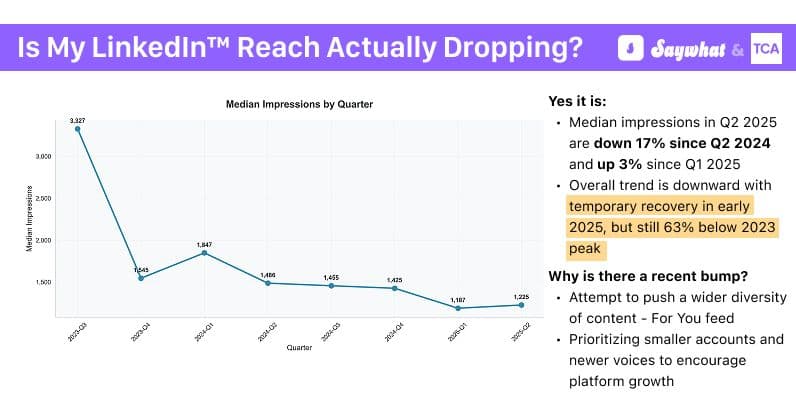
But the reach decline is just part of the story. In mid-June 2025, LinkedIn rolled out what they called a test of "a new sort of efficient frontier" - basically, they decided that showing you new content wasn't as important as showing you "relevant" content. The result? Your feed is now a mix of:
- Posts from 3 weeks ago appearing at the top of your feed
- Suggested content from accounts outside your network
- Viral posts from 2 weeks ago still making the rounds
- Updates from connections that are weeks old
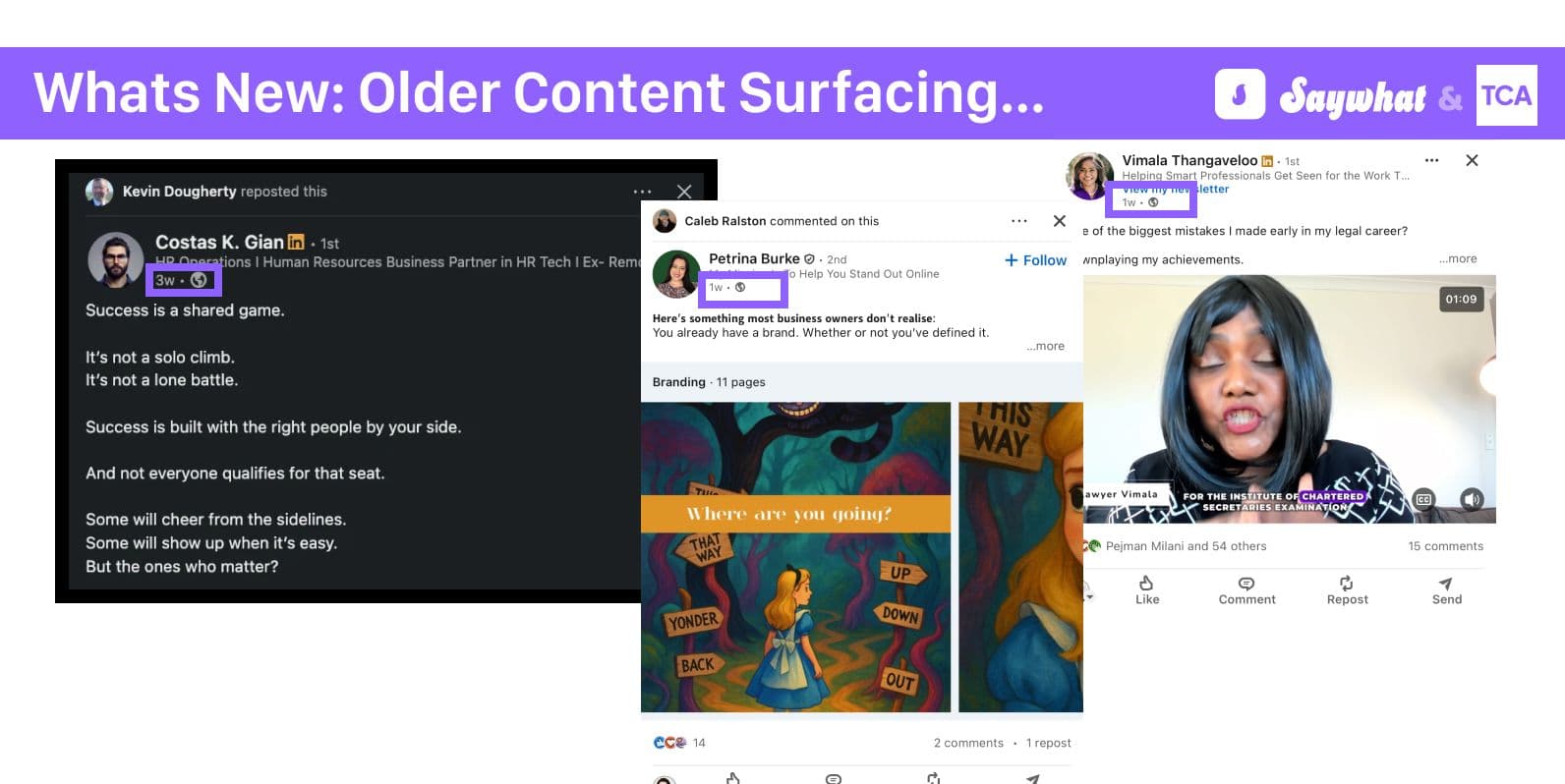
According to LinkedIn's VP of Product Management, Gyanda Sachdeva, this was intentional. They wanted to make sure you didn't miss "important" updates like job changes or career milestones, even if they happened weeks ago.
The algorithm now prioritizes based on:
- Sustained engagement loops: If a post keeps getting comments days later, it stays alive
- Your relationship with the poster: Your manager's old post ranks higher than newer content from others
- Time-zone independent distribution: Posts get stretched across time zones, meaning they can show up for weeks
Huge Gap Between The Best And The Rest
There is still a massive gap between the best and the rest. The Top 1% of content gets 381x the reach of the median post. Given the increased competition in the feed, it is more important than ever to make quality content.
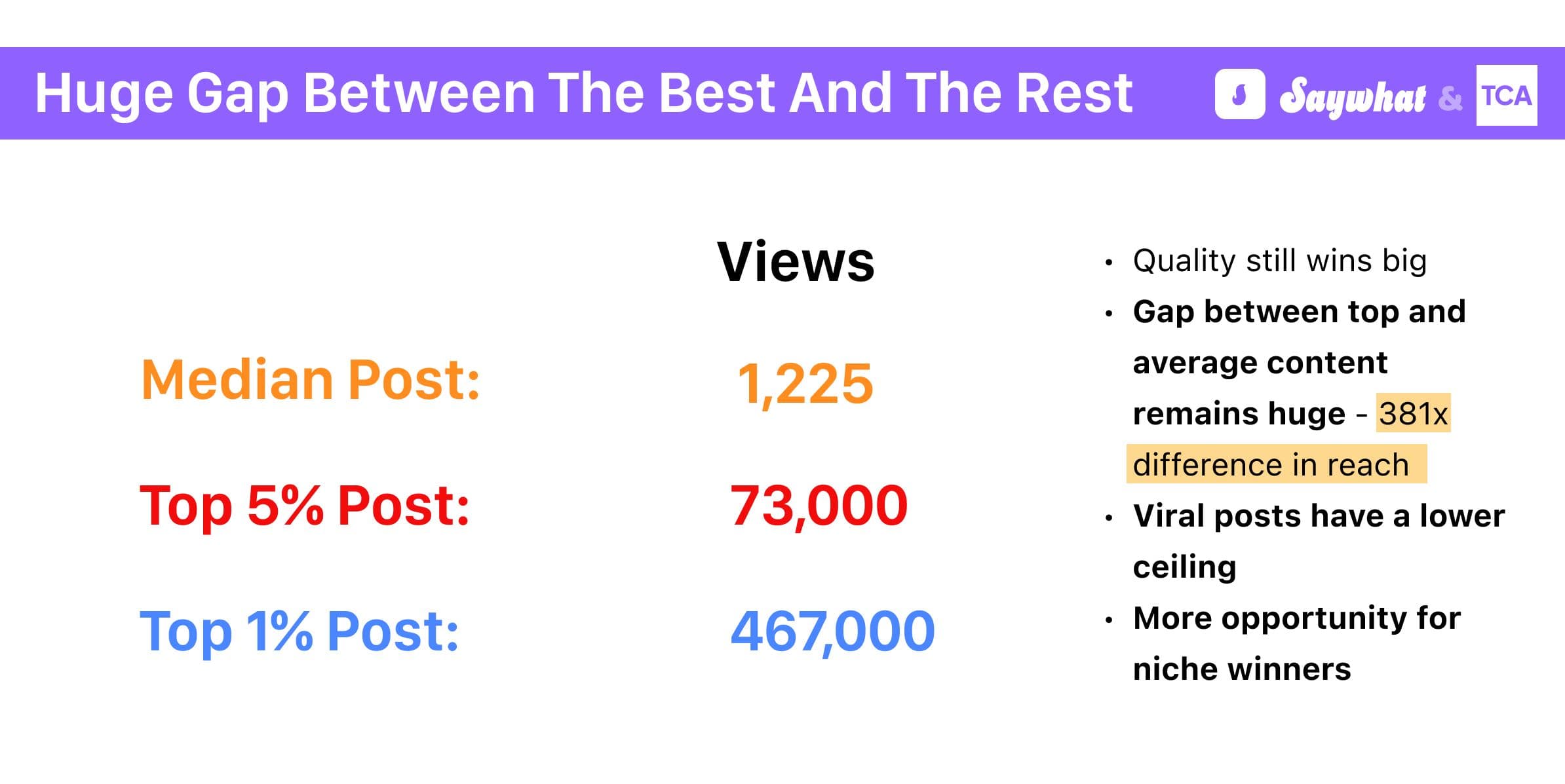
However, there is a silver lining: LinkedIn is actively trying to diversify content and give smaller accounts and more niche content more visibility. The "For You" feed is pushing content from new voices, not just the big influencers. If you're starting from scratch in 2025, this might actually be your moment.
Carousels: The Gold Rush Has Ended
In Q1 2025, carousels were getting 11.2x the reach of text posts. By Q2 that dropped to 3.7x. The gold rush is officially over.
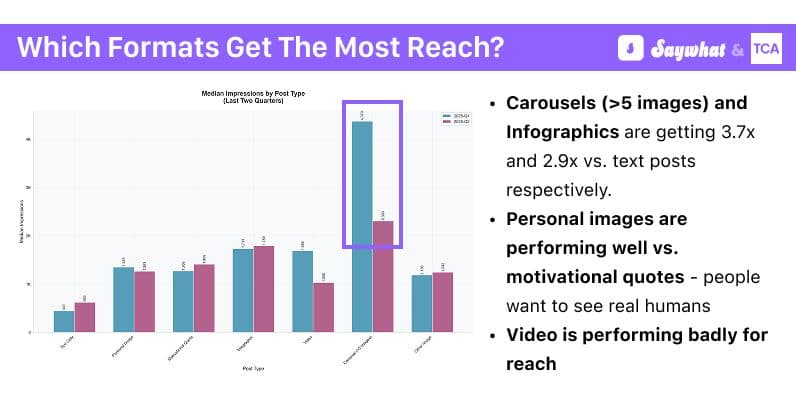
Here's what happened: everyone started doing them. My feed by mid-2025 was 90% carousels. Now, LinkedIn's users are bored of them.
But before you abandon carousels completely, understand this: 3.7x is still massive. It is still the best format for reach. They're not dead - they're just normalized. The key is using them strategically:
When Carousels Still Outperform
- Educational frameworks: Step-by-step guides, processes
- Data visualizations: Statistics, comparisons, trends
- Before/after transformations: Case studies with visuals
- Tool comparisons: Feature breakdowns, pricing charts
I now think of them as part of a broader strategy, with personal pictures and case studies. Carousels and infographics for reach. Personal pictures for connection. Case studies for sales.
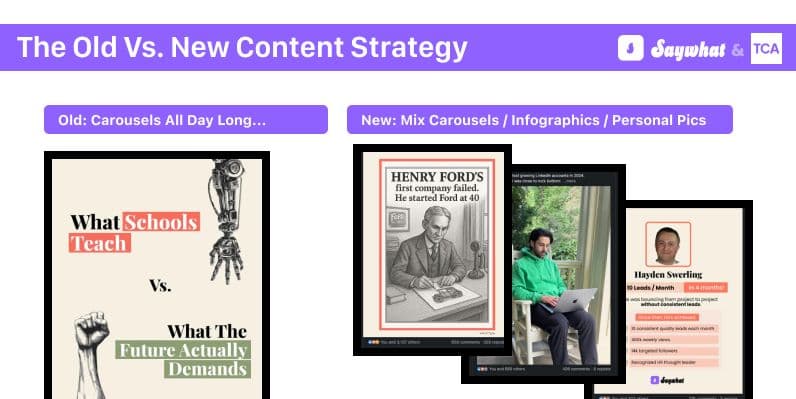
Personal Photos vs. Billboards: The Authenticity Algorithm
Personal images are getting 2x the reach of text posts. Everyone used to hate on selfies but with all the AI slop everywhere, people are now craving humanity.
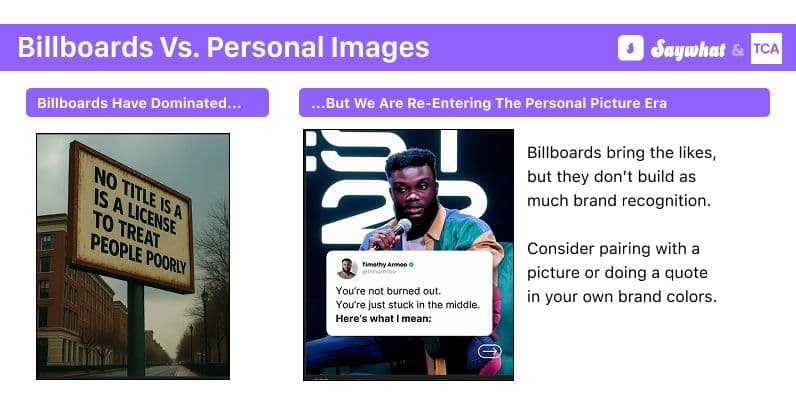
The key is to show photos of you actually doing the work (not just selfies) - leading a workshop, giving a presentation, at a conference - that's real social proof.
What Personal Photos Work
- Behind-the-scenes work moments
- Team photos and collaboration shots
- Speaking or teaching moments
- Even well-lit photos of you at your desk (seriously)
Pro tip: Portrait images get 62% better reach than landscape. They take up more feed real estate on mobile, where most consumption happens. The ideal dimensions are 1200 x 1500.
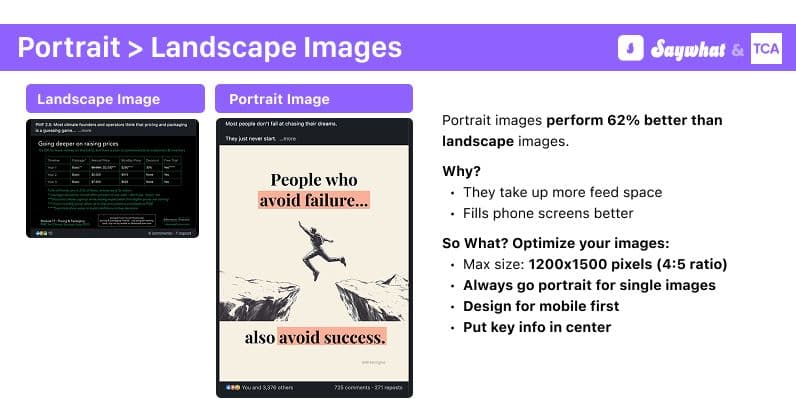
LinkedIn Video Is Dead (But Not Useless)
Remember when everyone was rushing to make 3-second videos? I watched one get 258,600 likes in Q1 2025. Those days are gone.
Video reach has absolutely cratered. We're talking worse performance than every other format except text-only posts. Those quick-hitting, viral-style videos that work on Instagram are not getting pushed.
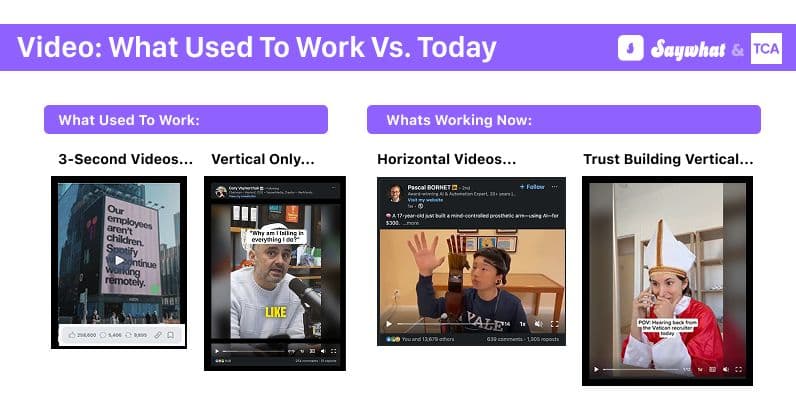
But here's what most people miss: video isn't completely dead. It's just serving a different purpose now. While video will rarely get you viral reach, it's become incredibly powerful for:
- Trust-building: Client testimonials, behind-the-scenes content
- Middle-of-funnel content: Product demos, case study walkthroughs
- Featured section assets: Videos in your profile's featured section convert visitors
The key is don't expect them to get crazy views and start thinking about trust building. A video with 10,000 views that lands you 3 clients beats a viral video with zero business impact.
What Works for Video in Q2 2025
- Horizontal videos (yes, really) - LinkedIn's desktop-heavy audience prefers them
- Videos with you actually in them - not faceless content
- Captions are non-negotiable - most people watch on mute
- 1-3 minute sweet spot - long enough to provide value, short enough to hold attention
The LinkedIn Text Post Comeback: Why Long-Form Content Is King Again
This is the most shocking finding from our data: posts with more than 2,500 characters get 45% better reach than short posts. After years of "keep it snappy," LinkedIn has done a complete 180.
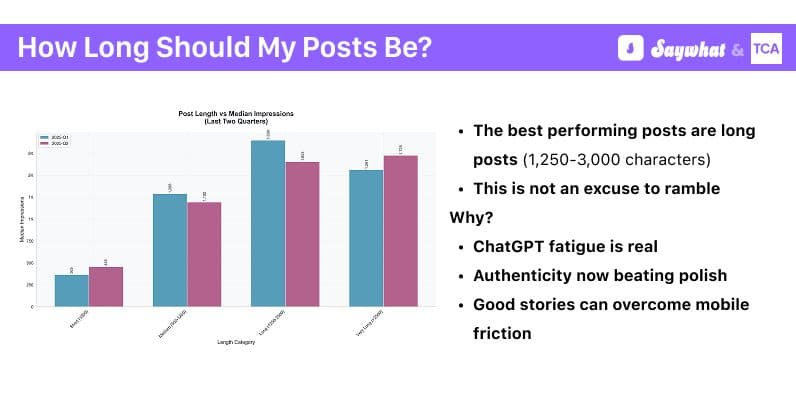
Why the shift? Two words: ChatGPT fatigue.
The platform is drowning in short, robotic posts that all sound the same. "Here are 5 tips for..." "Unpopular opinion: you should work hard." People are craving humanity, stories, and actual insights.
The Conversational Writing Formula
Here's what's working:
- Write like you talk (seriously, read it out loud)
- Include specific details and personal anecdotes
- Break up text with 14+ short paragraphs
- Use 5-7th grade reading level (run it through Hemingway Editor)
- Add 1-8 emojis for readability
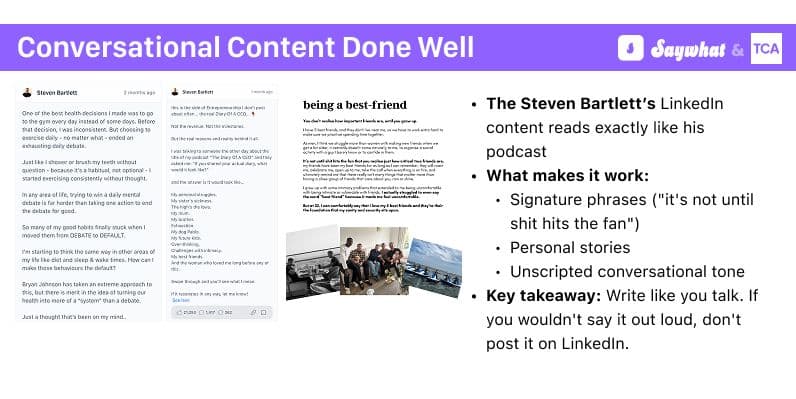
LinkedIn's rewarding authenticity over polish. Those typos you used to obsess over? Leave them. That conversational phrase your English teacher would hate? Use it.
The Link Paradox: External Links Done Right BOOST Reach
This completely breaks everything we thought we knew: posts with 3+ links are getting 140% better reach than posts without links.
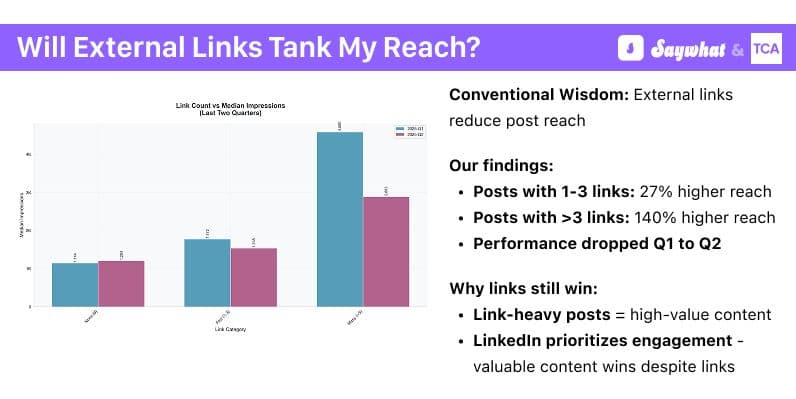
For years, the advice was to avoid links or put them in comments. LinkedIn supposedly hated sending people off-platform. But here's what's actually happening:
When you share multiple helpful links - job opportunities, tools, useful resources - more people stop and read. You're not driving people away; you're establishing yourself as a valuable filter for your industry.
How to Use Links Without Penalty
- Share 3+ genuinely valuable resources
- Make the post valuable even without clicking links
That said, the Q1 to Q2 performance drop suggests LinkedIn might be getting stricter. The key is ensuring your linked content provides genuine value, not just driving traffic to your latest blog post.
The LinkedIn Hook Fatigue Crisis (And What Works Instead)
"Unpopular opinion: toxic leaders are bad" hooks are falling flat. Weak pattern interrupting hooks are now so common they're predictable, and the people are bored of them.
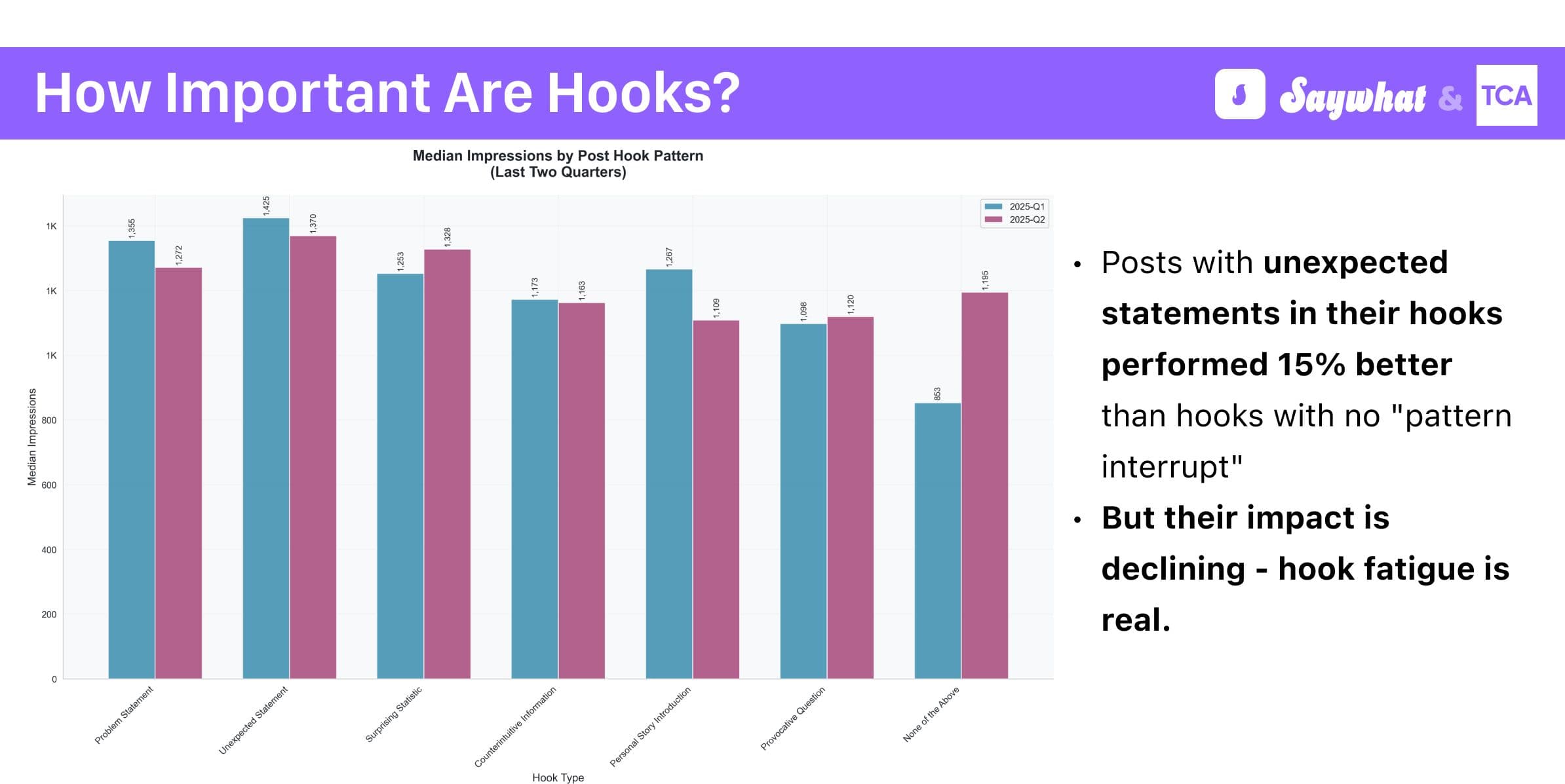
Pattern interrupt hooks only give you a 15% boost now, down from much higher in Q1. But authority hooks - leading with credentials and specific expertise - are the way to stand out in the age of AI.
People with AI can copy your words but they can't copy your experience!
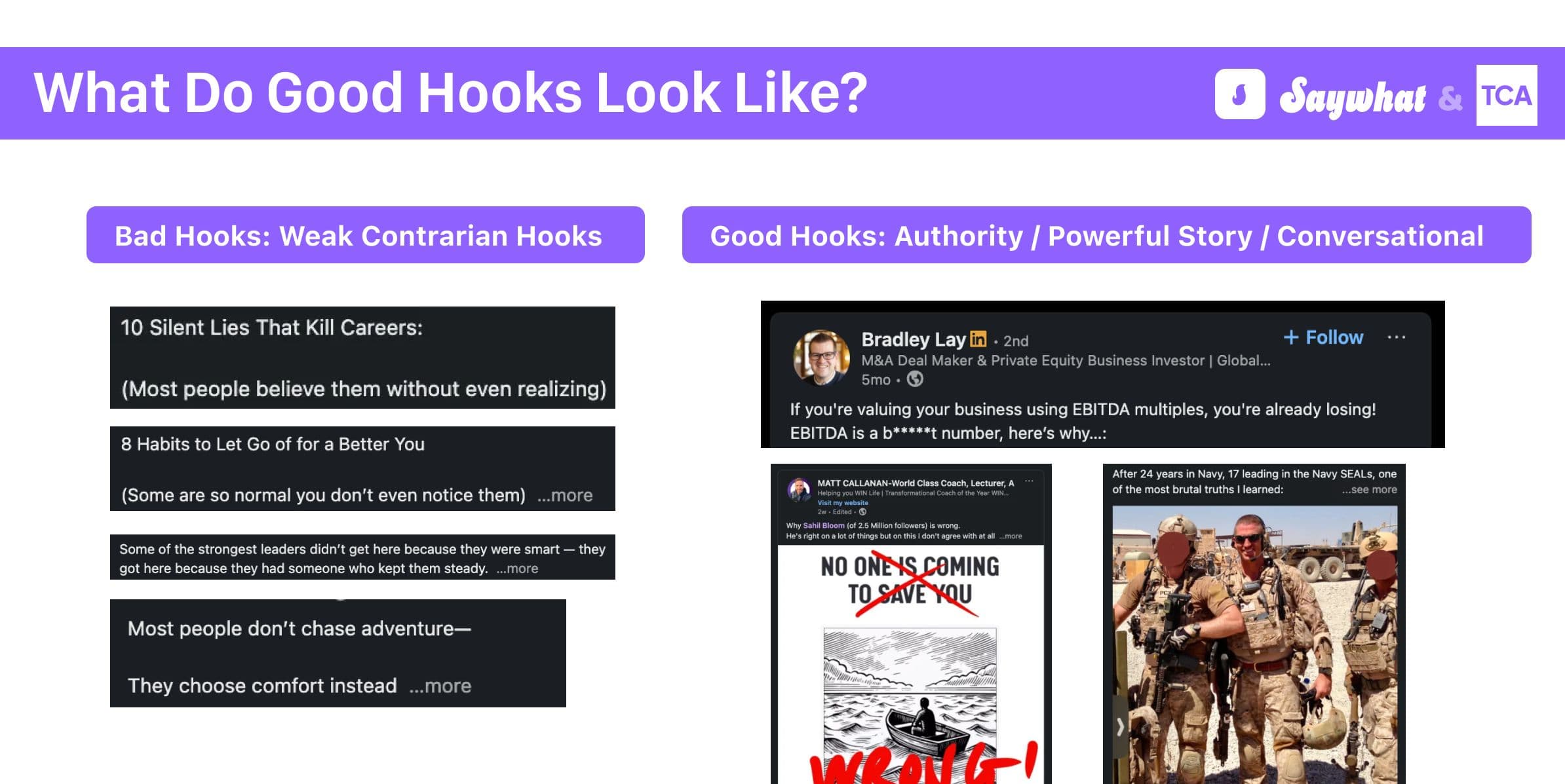
Authority Hook Examples That Work
❌ Weak: "Here's what I learned about growing on LinkedIn."
✅ Strong: "After analyzing 2.4M posts and building a 347K following in 13 months, I discovered something surprising."
❌ Weak: "Unpopular opinion: consistency matters"
✅ Strong: "I posted daily for 365 days and lost 10,000 followers. Here's what actually drives growth."
The key is specificity and credentials. Don't just claim expertise - prove it in your opening line.
Comments: The Hidden Algorithm Multiplier
Top 5% creators comment 282% more than average creators. They're not just posting and ghosting - they're building relationships through thoughtful engagement.
It's not about the sheer volume. Generic "Great post!" comments are worthless. The algorithm can detect (and ignores) low-effort engagement.
What Makes a Valuable Comment
- Share a relevant personal experience
- Add data or insights not in the original post
- Ask a thoughtful follow-up question
- Respectfully challenge or expand on ideas
- Minimum 2-3 sentences of substance
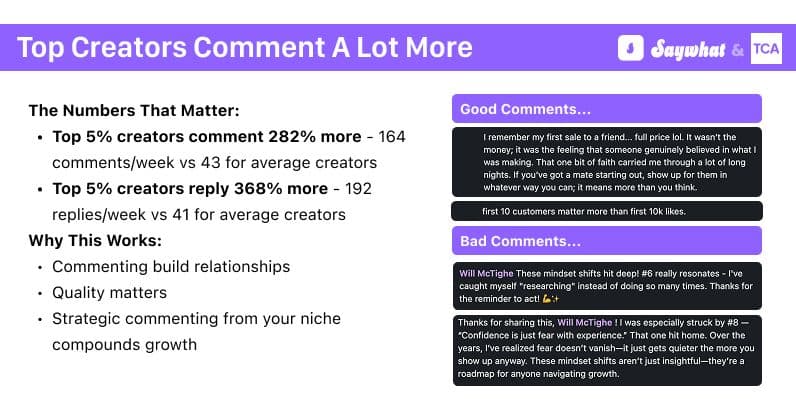
The 80/20 Content Creation Rule: Why Most Content Fails (And That's OK)
Content creation is a game of outliers.
Even for top 1% creators, 76% of their posts underperform. Read that again. The best creators on LinkedIn fail 4 out of 5 times.
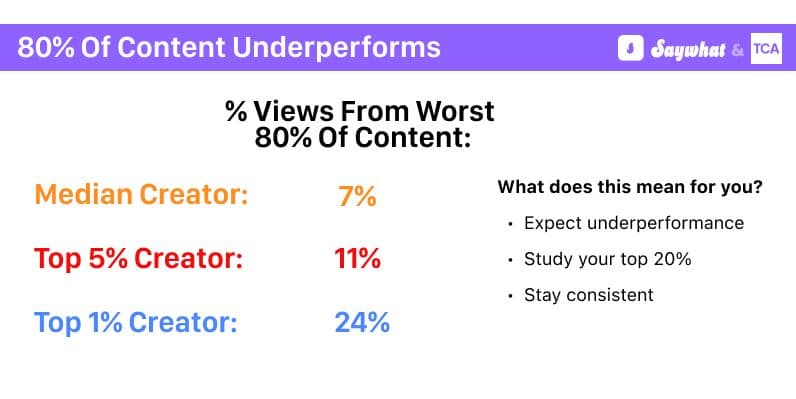
The difference is that top creators embrace this volatility. They know that one hit funds 10 experiments. They're playing a volume game with quality content.
Meanwhile, the average creator get discouraged after a few flops and quit. They're optimizing to avoid failure instead of maximizing for breakthrough hits.
What This Means for Your Strategy
- Post consistently even when posts flop
- Analyze your top 20% to find patterns
- Take bigger creative risks
- Stop playing it safe with generic content
- One viral post can carry a month of "failures"
Your ceiling is your problem, not your floor. Focus on creating potential breakout hits, not avoiding duds.
Data Disclaimer
The insights in this report are based on analysis of 223,996 LinkedIn posts from anonymized Saywhat users.
While this represents a large sample size, individual results may vary based on industry and audience. LinkedIn's algorithm continues to evolve, and strategies that work today may need adjustment tomorrow.
All data points are aggregated and anonymized. No individual user data was exposed in creating this report.
How Saywhat Can Help You Master the New Algorithm
I've spent the last 18 months obsessing over LinkedIn's algorithm changes. Testing, analyzing, adjusting. It's exhausting. That's why we built Saywhat - to give you the tools and insights that took me from 3,000 to 390,000+ followers.
We analyze millions of posts to spot trends before they become common knowledge and share them in our community first. The insights in this post - they come from real data, not guesswork.
Ready to grow your LinkedIn presence with strategies that actually work in 2025? Try Saywhat free for 7 days and see how the right tools can transform your content strategy.
Start building your personal brand today.
Join top executives and creators in using our AI-powered writing, community, and lead gen tools to scale your LinkedIn business.
